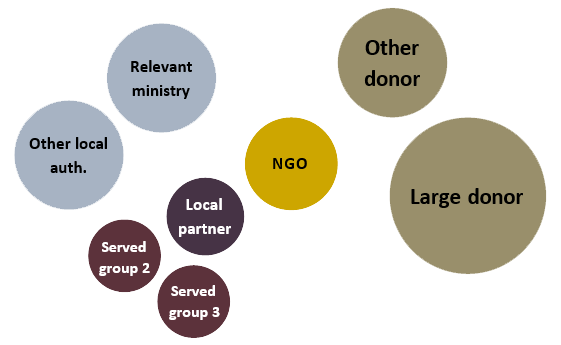Section 05: Getting organised
5.1 Phases of a typical strategy process
A typical strategy development process might look like this:
5.2 Getting a team together
Strategic planning is not an individual exercise. It helps to bring together a task force to ensure the process is considered and comprehensive. This group may help identify:
The key strategic questions and choices;
Who to listen to and how;
Who to ask for facilitation support.
5.3 Identifying key questions
All organisations face different strategic choices at any point in time. These may be specific to the NGO, or variants on common NGO dilemmas:
Do we give a little help for many, or more intensive support for few?
Do we treat the symptoms, or try to get to the cause?
Do we provide services, or campaign for change in the systems?
Do we focus, or do we diversify our services?
Do we hold virtuously to our beliefs, or are we tempted by new resources?
While these choices may not always be so ‘either/or’ as they appear, simultaneously trying to do both poses considerable challenges.
“A goat cannot run in two directions at once without being torn in two.” - African proverb
5.4 Deciding who to involve
Strategic planning provides an excellent opportunity to gather the views of the NGO’s beneficiaries, staff, managers, donors, other NGOs and other stakeholders of the organisation. Participation creates a sense of ownership in the process of strategy development. Ownership encourages the commitment needed to put it into practice.
The people and organisations the NGO seeks to serve (whether partners or ultimate beneficiaries) should be involved in any strategy process. They know best about change on the ground. All too often their voices are excluded when deciding what the NGO should focus on and how it should work.
Boards can and should play an important role, particularly with smaller NGOs. Ultimately the board has to approve the strategic plan, but how involved they are in the process depends on the situation. Where the NGO has few, if any, paid staff, the board usually has to be heavily involved.
Any staff, whether working in the field or in management, should all be involved. They each have different perspectives to bring and complementary roles to play. Field staff may have the best view of what would work, but may have too much personal investment in the outcome. Because strategy involves hard choices, leadership will need to make tough decisions with board support.
A stakeholder analysis can be useful in deciding who should be involved in the strategy development process. More information about this is presented below.
There are many variants on the simple stakeholder analysis. In its most basic form, it involves identifying all those groups who have a stake or an interest in your work.
These can be drawn as circles of different sizes (illustrating power to influence the NGO) and placed closer or further away from the NGO (illustrating the extent of or frequency of contact). You can draw your stakeholder analysis on a flipchart or by arranging sticky notes, but also with any "mind mapping" templates freely available on the internet.
Last updated

